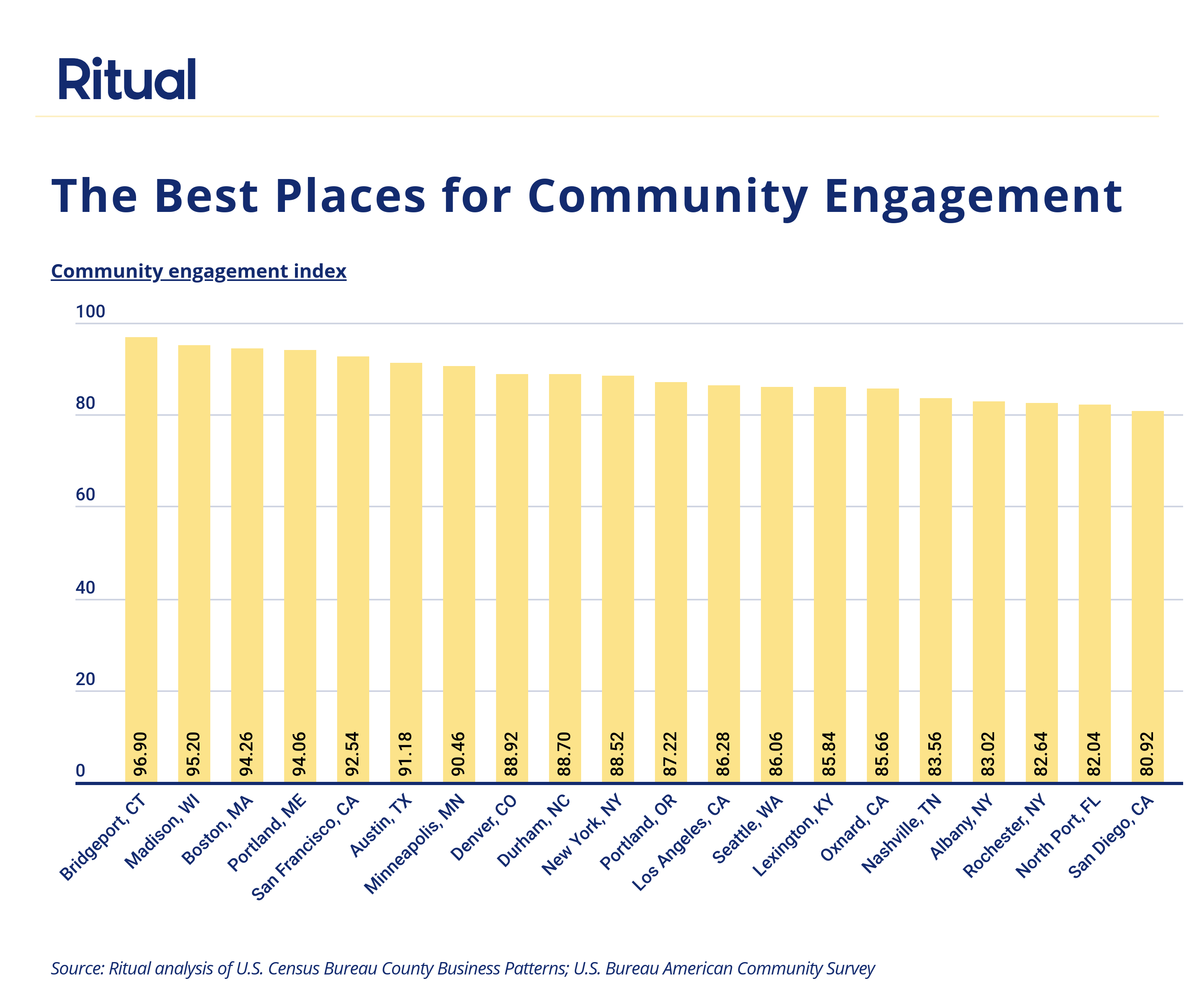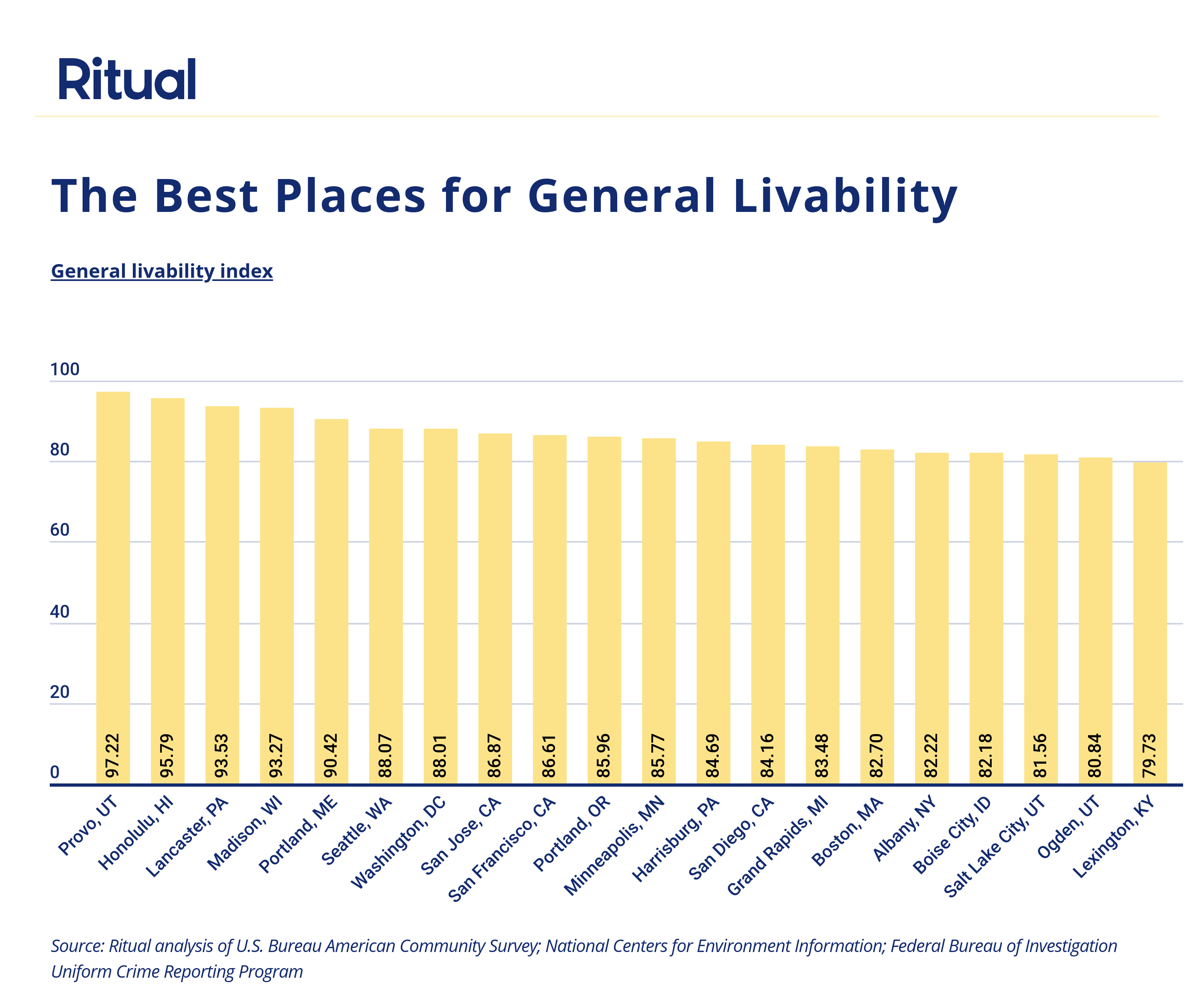5. Bridgeport-Stamford-Norwalk, CT
Overall score: 86.13
Health care & outcomes: 82.94
Community engagement: 96.90
General livability: 79.62
Population: 943,823
Located along the Long Island Sound, Bridgeport is a port city with five historic districts. The metro’s residents are more likely than residents in most other metros to have earned a bachelor’s degree with nearby universities including the University of Connecticut-Stamford, Fairfield University, and Sacred Heart University. Residents of the Bridgeport metro area are also less likely to be obese. With such close proximity to the water, residents can visit the public beaches at Cove Island Park and Cummings Park to swim, sunbathe, or go for a jog along the shore.
6. Minneapolis-St. Paul-Bloomington, MN-WI
Overall score: 86.07
Health care & outcomes: 83.01
Community engagement: 90.46
General livability: 85.77
Population: 3,629,190
Twin Cities residents are far more likely than residents in other metros to consider themselves in very good or excellent health. Minnesota has earned its moniker the Land of 10,000 Lakes, and those living in Minneapolis-St. Paul can use the lakes for year-round exercise like hockey in the winter and kayaking in the summer. In addition, the local Wirth Winter Recreation Area Trails are perfect for skiing. During the spring and summer, residents can also enjoy jogging in the city’s many parks and wetlands.
7. Washington-Arlington-Alexandria, DC-VA-MD-WV
Overall score: 85.32
Health care & outcomes: 87.33
Community engagement: 79.96
General livability: 88.01
Population: 6,249,950
History buffs will love the greater Washington D.C. metro area and its easy access to institutions like the Smithsonian. Like many of the other cities on this list, Washington D.C. boasts one of the highest percentages of residents with a bachelor’s degree. The nearby Shenandoah National Park and Great Falls State Park provide green spaces for exercise and exploration. Similarly, the cities of Arlington and Alexandria are only a few stops away on the metro system, connecting residents to historic sites like Arlington National Cemetery and Mount Vernon.
8. San Diego-Carlsbad, CA
Overall score: 84.92
Health care & outcomes: 88.49
Community engagement: 80.92
General livability: 84.16
Population: 3,343,364
San Diego has one of the most pleasant climates in the country and is famous for its sunshine and beaches. The temperate weather fosters a love of the outdoors and encourages residents to maintain an active lifestyle with its numerous hiking trails, beach sports, and sporting facilities like golf courses and tennis courts. San Diego is also home to the famous San Diego Zoo and beautiful Balboa Park.
9. Seattle-Tacoma-Bellevue, WA
Overall score: 84.74
Health care & outcomes: 81.25
Community engagement: 86.06
General livability: 88.07
Population: 3,939,363
On average, Seattle residents are well educated and physically active.The city is known for its breathtaking landscape, including natural wonders like Mount Rainier and the Puget Sound. Seattle offers a variety of activities such as attending live outdoor performances, chatting with friends in one of the city’s numerous coffee shops, or escaping to local ski resorts, hiking trails, and state parks. The variety of activities enables Seattle residents to maintain excellent mental, emotional, and physical health.
10. Portland-Vancouver-Hillsboro, OR-WA
Overall score: 83.75
Health care & outcomes: 79.49
Community engagement: 87.22
General livability: 85.96
Population: 2,478,810
Situated in the lush landscape of the Pacific Northwest, Portland boasts numerous urban parks, as well as adventure activities such as hiking in the nearby mountains or exploring the Columbia River Gorge. For those who enjoy riding bikes, bike-sharing is a common and healthy way to travel around the city. It’s also easy to eat healthy in Portland, especially with its plethora of restaurants specializing in vegan, vegetarian, and Paleo cuisine.
11. Los Angeles-Long Beach-Anaheim, CA
Overall score: 83.37
Health care & outcomes: 92.79
Community engagement: 86.28
General livability: 67.90
Population: 13,291,486
Among all large cities, Los Angeles has the lowest rate of depression among its residents. Los Angeles is also well-known for the diversity of its residents and things to do. Earning its nickname as the Entertainment Capital of the World, Los Angeles has the most arts, entertainment, and recreational facilities relative to its population. The city’s year-round sunny weather encourages residents to spend a lot of time outside in the surrounding area’s diverse landscape including beaches, mountains, and forests.
12. Boston-Cambridge-Newton, MA-NH
Overall score: 83.19
Health care & outcomes: 75.25
Community engagement: 94.26
General livability: 82.70
Population: 4,875,390
The Boston area’s numerous colleges and universities, including Harvard, MIT, and Boston College, have made it one of the most educated cities in the U.S. This densely populated city offers one of the highest concentrations of arts, entertainment, and recreational facilities, including the New England Aquarium and Museum of Fine Arts. Walking along the Freedom Trail and other historic sites is an excellent way to enrich both the body and the mind.
13. Denver-Aurora-Lakewood, CO
Overall score: 81.80
Health care & outcomes: 80.21
Community engagement: 88.92
General livability: 76.79
Population: 2,932,415
Nestled in the heart of the Rocky Mountains, the Mile High City is home to numerous parks, golf courses, and ski resorts that beckon residents to spend time being active outdoors. Since maintaining balance is important for good health, less strenuous cultural enrichment options include attending sports games or shows at the performing arts complex. Due to the city’s high altitude, Denverites are advised to take care of their health by drinking more water and adjusting their diet and physical activity level as needed.
References:
- Life Expetancy Calculator. United States Social Security Administration.
- Xu, J. (2016). Mortality Among Centenarians in the United States, 2000─2014. NCHS Data Brief, 233.
Our Methodology
To identify the best metropolitan areas for healthy aging, a composite score was created based on the following metrics:
-Health care & outcomes (40%): Percentage of adults in very good or excellent health; Level of physical activity; Health care facilities & workers per capita; Additional health care factors and lifestyle habits
-Community engagement (30%): Density of arts, entertainment, & recreation facilities; Density of civic & religious organizations; Educational attainment (overall & adults 65+)
-General livability (30%): Unemployment rates (overall & adults 65+); Poverty rates (overall & adults 65+); Commuters who walk; Commuters who bike; Mean commute time; Weather; Violent and property crime rates
Only metropolitan areas with at least 500,000 people were included in the analysis. Data sources include: U.S. Census Bureau American Community Survey; U.S. Census Bureau County Business Patterns; U.S. Bureau of Labor Statistics Occupational Employment Statistics; National Centers for Environment Information; Federal Bureau of Investigation Uniform Crime Reporting Program; Centers for Disease Control and Prevention Behavioral Risk Factors.














